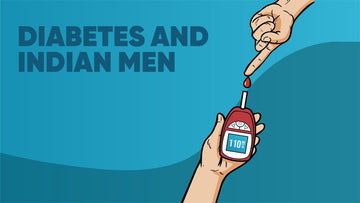
Diabetes poses a major health problem globally and is one of the top five leading causes of death in most developed countries. A substantial body of evidence suggests that it could reach epidemic proportions particularly in developing and newly industrialized countries.
Indeed, by the year 2025, three-quarters of the world’s 300 million adults with diabetes will be in developing countries and almost a third in India and China alone. The World Health Organization has estimated that in 1995, 19.4 million individuals were affected by diabetes in India and these numbers are expected to increase to 57.2 million by the year 2025 i.e. one-sixth of the world total. The revised figures are 80.9 million by the year 2030.
Looking at the region-wise prevalence of diabetes, in a recent study conducted among urban subjects [National Urban Diabetes Survey (NUDS)] the prevalence of diabetes in the southern part of India was found to be higher -13.5% among Chennai residents, in Bangalore, 12.4% and Hyderabad,16.6% than eastern India, 11.7% (Kolkata), northern India, 11.6% (New Delhi) and western India, 9.3% (Mumbai). Thus it is clear that in the last two decades, there has been a marked increase in the prevalence of diabetes among urban Indians, with a suggestion that Southern India has seen the sharpest increase.
REASONS FOR ESCALATION IN DIABETES PREVALENCE IN INDIAN MEN:
1: Increased Insulin resistance:
One of the important factors contributing to increased Type 2 diabetes in Indians is the fact that they have a greater degree of insulin resistance. Studies by Yajnik et, demonstrated that low birth weight is a contributor to insulin resistance among Indians.
2: Stronger Genetic Factors in Indians:
Various studies on migrant and native Indians indicate that Indians have an increased predilection to diabetes which could well be due to a greater genetic predisposition to diabetes in Indians. Genetic susceptibility appears to play an important role in the occurrence of Type 2 diabetes. However, Type 2 diabetes is known to be a multifactorial disease caused by a complex interplay of genetic (inheritance) and environmental (diet and lifestyle) factors.
3: Environmental Factors:
Currently, India is undergoing a rapid epidemiological transition with increased urbanization. Socio-economic development over the last 40-50 years has resulted in a dramatic change in lifestyle from traditional to modern, leading to physical inactivity due to technological advancement, affluence leading to consumption of diets rich in fat, sugar, and calories and a high level of mental stress. All these could adversely influence insulin sensitivity and lead to obesity.
4: Obesity:
The intimate relationship between diabetes and obesity has given rise to the term “diabesity” to characterize the close association of these two disorders. In his study men with a BMI of > or = 35 kg/m2 had a multivariate RR of 42.1 for Type 2 diabetes compared with men with a BMI < 23.0 kg/m2.
5: Dietary alterations:
In India, as urbanization and economic growth occur, there are major deviations in the dietary pattern which are influenced by the varied cultural and social customs. Traditional dietary patterns are disappearing as Indians are adapting themselves to living in the more industrialized, urban environments that are brought about by globalization.
The major dietary changes that urbanization and affluence bring about are, the substitution of unrefined wheat, rice, or millets by highly polished wheat or rice and increased intakes of fat in higher-income groups.
A high intake of saturated fatty acids has been associated with an increased risk of developing impaired glucose tolerance (IGT) and diabetes and of progression to diabetes from IGT, whereas unsaturated fatty acids, especially n-3 polyunsaturated fatty acids, have been inversely associated with the risk of diabetes
It is thus clear that the diabetes epidemic experienced in India may be due to strong genetic factors coupled with urbanization and lifestyle changes leading to insulin resistance.
There is also strong evidence that Indians have a greater degree of insulin resistance and a stronger genetic predisposition to diabetes. As several of the factors associated with diabetes are potentially modifiable, this epidemic of diabetes can be curbed if proper measures are taken to increase physical activity and reduce obesity rates in adults, and most importantly, in children. In addition, strategies to achieve healthy fetal and infant growth and encouraging the use of traditional diets rich in fiber are also important steps. Such interventions should be attempted in those who are genetically predisposed to diabetes to tackle the explosion of, and thereby reduce the burden due to, diabetes within the Indian subcontinent.
Reference:
- King H, Aubert RE, Herman WH: Global burden of diabetes, 1995-2025: prevalence, numerical estimates, and projections. Diabetes Care 1998; 21:1414-1131.
- Fall CH. Non-industrialized countries and affluence. Br Med Bull 2001;60:33-50.
- Ramachandran A, Snehalatha C, Kapur A, et al. Diabetes Epidemiology Study Group in India (DESI). High prevalence of diabetes and impaired glucose tolerance in India: National Urban Diabetes Survey. Diabetologia 2001; 44:1094 - 1101.
- Gopalan C. Rising incidence of obesity, coronary heart disease, and diabetes in the Indian urban middle class. Possible role of genetic and environmental factors.World Rev Nutr Diet 2001;90:127-143.
- Storlein LH, Baur LA, Kriketos AD, et al. Dietary fats and insulin action. Diabetologia 1996;39: 621-631.




